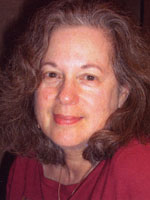
Judith P. Klinman
University of California at Berkeley
The Mafia and the Melting Pot
The Gordon Research Conferences have dominated my scientific career for more than thirty years. My first GRC venture came in 1972, when as a young research scientist at the Institute for Cancer Research in Philadelphia, I was invited by Gene Cordes to attend the Enzymes, Coenzymes, and Metabolic Pathways GRC. I presented my work on kinetic isotope effects in the alcohol dehydro-genase reaction, the oxidation of alcohol to aldehyde. I remember my terror in speaking for the first time in front of the brilliant “mafia” of enzymologists that normally lined the front rows of the lecture hall. This venerable conference still serves as a proving ground for young scientists and is an important venue for the interplay of
chemistry and biology (and was so even long before the now-fashionable term
chemical biology had been coined). The Enzymes Conference has remained an intellectual powerhouse, with many of the field’s giants of the second half of the twentieth century participating, like Frank Westheimer, Mo Cleland, Ernie Rose, Bill Jencks, and Bob Abeles.
Other Gordon Conferences have also played large roles in my scientific career. Beginning in the late 1980s international interest was growing in the idea that certain new enzymatic cofactors were covalently linked to proteins, particularly that one low-molecular-weight bacte-rial cofactor called pyrroloquinoline quinone (PQQ) was attached to a large number of eukaryotic proteins. This attention instigated a new Gordon Conference in 1990 that focused on PQQ and was called Quinoproteins and Pyrroloquinoline Quinone. My laboratory had been struggling with one of the prototypic PQQ enzymes, a bovine serum amine oxidase (BSAO). In the year preceding the second GRC on PQQ we had finally sorted out the identity of the cofactor in BSAO, finding that it was indeed a quinone but one with a structure very different from PQQ. I remember experiencing the thrill of presenting data that were finally able to specify the nature of one of the new eukaryotic cofactor structures, but my feelings were mixed with some regret that I had failed to provide preprints of our work to the PQQ proponents in advance of the meeting. By the end of the GRC it was clear that the conference needed a name change. With the growing roles for novel cofactors and free radicals in enzymatic reactions, this relatively young field is now represented by a GRC called Protein Derived Cofactors, Radicals, and Quinones.
Another Gordon Conference has also played a dominant role in my research career–Isotopes in Biological and Chemical Sciences, a descendant of the Isotopes Conference (which is one of the oldest Gordon Conferences, having celebrated its fiftieth anniversary in 2004). The Isotopes Conference emerged in the aftermath of World War II because of the important role isotopes had played in weapons development. From the outset the conference was focused on the origins of equilibrium and kinetic isotope effects and their application to reaction mechanisms. A major figure in the field is Jake Bigeleisen, whose theoretical treatise on semiclassical isotope effects dominated the field for three decades.
The Isotopes GRC has always represented a unique melting pot of disciplines, welcoming physiologists, geochemists, and atmospheric chemists, for whom isotopes play a major role in research. In the 1970s enzymologists recognized the capacity of isotope effects to expand greatly the interpretive power of enzyme kinetics, and a new era was under way. Early on, data emerging from enzyme studies of hydrogen transfer showed discrepancies that appeared to be incompatible with the dominant semiclassical theory. My lab’s experimental work ultimately played a key role in these revelations, and I remember well the initial resistance to the shifting paradigm. In the best tradition of the GRC, and illustrating
the crucial interplay among disciplines in advancing science, biochemists and physical chemists with a common interest in isotopes moved toward theory dominated by quantum mechanical tunneling in hydrogen transfer in condense phase. As indicated by the most recent Gordon Conference on isotopes, Isotopes in Biological and Chemical Sciences, the implications of this tunneling behavior for our understanding of the origins of hydrogen isotope effects and enzyme catalysis continue to be a major source of debate and inquiry.
During my scientific career I have been privileged to participate in and serve as chair for each of the conferences discussed above. Some of the insights gleaned from these disciplines have spilled over into other conferences, such as the Metals in Biology GRC. For example, after hearing a lecture by Joe Berry from the Carnegie Institute on oxygen isotope effects in the O
2 side reaction of the enzyme rubisco, my lab initiated a series of experiments in which oxygen isotope effects serve as an important probe into the nature of O
2 activation in a diverse family of metallo-enzymes.
During the last three decades the guiding hands of Alexander Cruickshank and, later, Carl Storm have been evident throughout the progress of GRC. I am especially appreciative of Carl’s vision and commitment to the ever-changing nature of science and, as a consequence, the conferences that represent the individual disciplines.